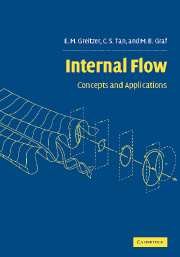Book contents
- Frontmatter
- Contents
- Preface
- Acknowledgements
- Conventions and nomenclature
- 1 Equations of motion
- 2 Some useful basic ideas
- 3 Vorticity and circulation
- 4 Boundary layers and free shear layers
- 5 Loss sources and loss accounting
- 6 Unsteady flow
- 7 Flow in rotating passages
- 8 Swirling flow
- 9 Generation of streamwise vorticity and three-dimensional flow
- 10 Compressible internal flow
- 11 Flow with heat addition
- 12 Non-uniform flow in fluid components
- References
- Supplementary references appearing in figures
- Index
4 - Boundary layers and free shear layers
Published online by Cambridge University Press: 14 January 2010
- Frontmatter
- Contents
- Preface
- Acknowledgements
- Conventions and nomenclature
- 1 Equations of motion
- 2 Some useful basic ideas
- 3 Vorticity and circulation
- 4 Boundary layers and free shear layers
- 5 Loss sources and loss accounting
- 6 Unsteady flow
- 7 Flow in rotating passages
- 8 Swirling flow
- 9 Generation of streamwise vorticity and three-dimensional flow
- 10 Compressible internal flow
- 11 Flow with heat addition
- 12 Non-uniform flow in fluid components
- References
- Supplementary references appearing in figures
- Index
Summary
Introduction
In this chapter, we discuss the types of thin shear layers that occur in flows in which the Reynolds number is large. The first of these is the boundary layer, or region near a solid boundary where viscous effects have reduced the velocity below the free-stream value. The reduced velocity in the boundary layer implies, as mentioned in Chapter 2, a decrease in the capacity of a channel or duct to carry flow and one effect of the boundary layer is that it acts as a blockage in the channel. Calculation of the magnitude of this blockage and the influence on the flow external to the boundary layer is one issue addressed in this chapter. Boundary layer flows are also associated with a dissipation of mechanical energy which manifests itself as a loss or inefficiency of the fluid process. Estimation of these losses is a focus of Chapter 5. The role of boundary layer blockage and loss in fluid machinery performance is critical; for a compressor or pump, for example, blockage is directly related to pressure rise capability and boundary layer losses are a determinant of peak efficiency that can be obtained.
Another type of shear layer is the free shear layer or mixing layer, which forms the transition region between two streams of differing velocity. Examples are jet or nozzle exhausts, mixing ducts in a jet engine, sudden expansions, and ejectors. In such applications the streams are often parallel so the static pressure can be regarded as uniform, but the velocity varies in the direction normal to the stream.
- Type
- Chapter
- Information
- Internal FlowConcepts and Applications, pp. 166 - 216Publisher: Cambridge University PressPrint publication year: 2004



